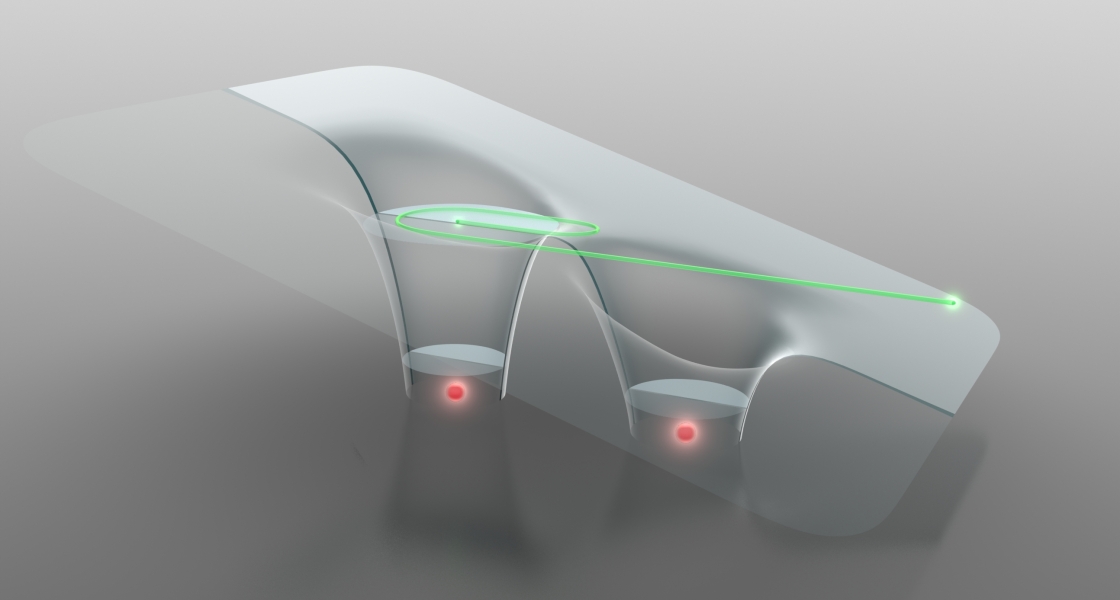There's something happenin’ here, what it is ain’t exactly clear -- Buffalo Springfield
Theorists Norio Takemoto (now at the Weizmann Institute of Science) and Fellow Andreas Becker figured that something was amiss when they first analyzed the details of what occurs when an ultrafast laser dislodges an electron from a “simple” molecular ion, H2+. Since H2+ has already lost one of its electrons, its two protons only have one electron left to play with. How hard would it be to “see” what happened to this electron in a strong laser field? After all, a widely accepted theory said that a strong laser field would make it easier for the lone electron to escape when the ion was stretched apart (as opposed to contracted). Thus, the strength of the laser field was supposed to correspond to a high probability of the loss of the remaining electron in a process known as ionization.
Takemoto and Becker were just going to fill in a few details in this story. But, to their surprise, their analysis revealed multiple bursts of ionization during one half of the oscillation of the laser electric field, including one burst earlier than expected and another later than expected. The later of the two extra bursts occurred when the lone electron temporarily (and somewhat randomly) surrounded one of the protons. This strange behavior appeared to be induced by the laser pulse itself.
About the time Becker and Takemoto were getting ready to send off an article to Physical Review Letters on the strange ionization behavior in H2+, Becker’s friend Reinhard Dörner of the Institut für Kernphysik at Germany’s J. W. Goethe-Universität contacted Becker, reporting that his experimental lab was studying the ionization of H2+, and “H2+ is doing something crazy.”
“Yes, I know,” Becker responded. He explained what their theoretical study had shown and agreed to enhance the new theory to take account of the particular experimental conditions in Dörner’s lab. The goal was to further explain the strange quantum swapping of the lone electron between the ion’s two protons. Because this quantum body swapping had been observed in both theory and experiment, the researchers were fairly sure it was real. It took Takemoto and Becker a year to complete their enhanced theoretical analysis that closely mirrored the German experiment, which had used a more complicated laser polarization (i.e., circular instead of linear) than had been modeled earlier.
Becker, Dörner, Takemoto, and their colleagues reported their results in the September 30, 2011, issue of Physical Review Letters. The researchers concluded that since the electron has wave-like properties, the laser field makes it behave like sloshing water. “There’s always some probability that the whole wave breaks up and one part will first slosh around one proton while the other part shoots out of the ion,” Becker explained. He added that the two protons can act like a double slit, with part of the electron wave swapping between the protons and then interfering with itself! This interference can causes a variety of strange and unexpected behavior, depending on whether it is constructive (the wave segments add together) or destructive (the wave segments subtract and disappear).
Unraveling this strange behavior was so much fun that Becker’s group is now working on designing a theoretical molecule with three or four protons to see what happens to a single electron inside this molecule when exposed to a strong laser field.



 The Physics Frontiers Centers (PFC) program supports university-based centers and institutes where the collective efforts of a larger group of individuals can enable transformational advances in the most promising research areas. The program is designed to foster major breakthroughs at the intellectual frontiers of physics by providing needed resources such as combinations of talents, skills, disciplines, and/or specialized infrastructure, not usually available to individual investigators or small groups, in an environment in which the collective efforts of the larger group can be shown to be seminal to promoting significant progress in the science and the education of students. PFCs also include creative, substantive activities aimed at enhancing education, broadening participation of traditionally underrepresented groups, and outreach to the scientific community and general public.
The Physics Frontiers Centers (PFC) program supports university-based centers and institutes where the collective efforts of a larger group of individuals can enable transformational advances in the most promising research areas. The program is designed to foster major breakthroughs at the intellectual frontiers of physics by providing needed resources such as combinations of talents, skills, disciplines, and/or specialized infrastructure, not usually available to individual investigators or small groups, in an environment in which the collective efforts of the larger group can be shown to be seminal to promoting significant progress in the science and the education of students. PFCs also include creative, substantive activities aimed at enhancing education, broadening participation of traditionally underrepresented groups, and outreach to the scientific community and general public.